
A cutaway on the guitar construction is an indentation in the upper bout of the guitar body adjacent to the guitar neck, designed to allow easier access to the upper frets.

A cutaway on the guitar construction is an indentation in the upper bout of the guitar body adjacent to the guitar neck, designed to allow easier access to the upper frets.
Cutaway bodies are mainly of interest when discussing acoustic guitars and semi-acoustic guitars; virtually all solid body guitars either have at least one cutaway, or have a body shape (such as the flying V guitar) which does not intrude into the upper neck area.
Some manufacturers denote instrument models with cutaway using the suffix C, such as the Gibson L5C or the Maton CW80C.
There are two main types of cutaways: Venetian and Florentine. [1] A Venetian cutaway has a rounded bout. A Florentine cutaway has a sharp bout. The terms probably originate with the Gibson Guitar Corporation and probably do not reflect historic instrument-making practices of Florence and Venice. [2]
A less common third type is the squared-off cutaway, used on the Selmer-Maccaferri guitar and some nylon-string guitars.
Instruments with only a lower cutaway are known as "single cutaway" instruments, and guitars with both are called "double cutaway". These terms are sometimes shortened to "single cut" (such as in the model name for a solid-body electric guitar called the "PRS Singlecut", produced by the Paul Reed Smith company) or "double cut".
As well as the more common lower cutaway, many instruments have an upper cutaway, sometimes smaller than the lower one, or sometimes about the same size. This is mainly seen on electric guitars, as the reduction in body size resulting from a double cutaway would be detrimental to the sound quality of an acoustic guitar. Double cutaways allow the thumb as well as the fingers to move past the neck-body join. In addition, the strap button on double cutaway guitars is typically positioned on the end of the upper horn, further up the neck than on guitars without a cutaway. This improves the instrument's balance when played with a strap. A double cutaway also facilitates left-handed use of right-handed instruments.
In some Gibson guitars, models with two cutaways are abbreviated with a "DC" after the name, such as in the Les Paul Studio DC, the Les Paul Standard DC, the Les Paul Special DC, and the Les Paul Junior DC. Since more single cut versions of these guitars are produced than the doublecut versions, if the model name of these guitars is not followed by "DC", "double cut", or "double cutaway", the assumed reference is to the single cutaway models.
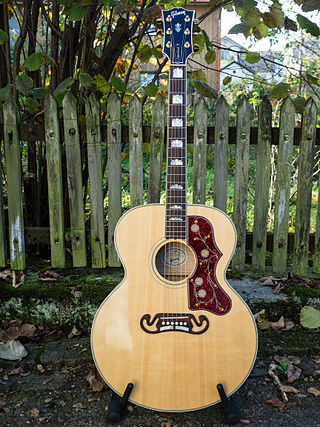
The steel-string acoustic guitar is a modern form of guitar that descends from the gut-strung Romantic guitar, but is strung with steel strings for a brighter, louder sound. Like the modern classical guitar, it is often referred to simply as an acoustic guitar, or sometimes as a folk guitar.

An electric guitar is a guitar that requires external amplification in order to be heard at typical performance volumes, unlike a standard acoustic guitar. It uses one or more pickups to convert the vibration of its strings into electrical signals, which ultimately are reproduced as sound by loudspeakers. The sound is sometimes shaped or electronically altered to achieve different timbres or tonal qualities from that of an acoustic guitar via amplifier settings or knobs on the guitar. Often, this is done through the use of effects such as reverb, distortion and "overdrive"; the latter is considered to be a key element of electric blues guitar music and jazz, rock and heavy- metal guitar playing. Designs also exist combining attributes of the electric and acoustic guitars: the semi-acoustic and acoustic-electric guitars.

The guitar is a fretted musical instrument that typically has six strings. It is usually held flat against the player's body and played by strumming or plucking the strings with the dominant hand, while simultaneously pressing selected strings against frets with the fingers of the opposite hand. A plectrum or individual finger picks may also be used to strike the strings. The sound of the guitar is projected either acoustically, by means of a resonant chamber on the instrument, or amplified by an electronic pickup and an amplifier.
Ibanez is a Japanese guitar brand owned by Hoshino Gakki. Based in Nagoya, Aichi, Japan, Hoshino Gakki were one of the first Japanese musical instrument companies to gain a significant foothold in import guitar sales in the United States and Europe, as well as the first brand of guitars to mass-produce the seven-string guitar and eight-string guitar. Ibanez manufactures effects, accessories, amps, and instruments in Japan, China, Indonesia, and the United States. As of 2017 they marketed nearly 165 models of bass guitar, 130 acoustic guitars, and more than 300 electric guitars. After Gibson and Fender, Ibanez is considered the third biggest guitar brand.
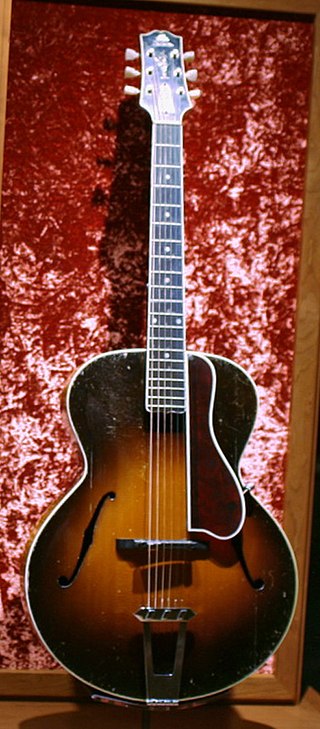
The Gibson L-5 is a hollow body semi-acoustic guitar first produced in 1923 by the Gibson Guitar Corporation, then of Kalamazoo, Michigan. The first guitar to feature F-holes, the L-5 was designed under the direction of acoustical engineer and designer Lloyd Loar, and has been in production ever since. It was considered the premier guitar of the company during the big band era. It was originally offered as an acoustic instrument, with electric models not made available until the 1940s.

The Gibson Les Paul is a solid body electric guitar that was first sold by the Gibson Guitar Corporation in 1952. The guitar was designed by factory manager John Huis and his team with input from and endorsement by guitarist Les Paul. Its typical design features a solid mahogany body with a carved maple top and a single cutaway, a mahogany set-in neck with a rosewood fretboard, two pickups with independent volume and tone controls, and a stoptail bridge, although variants exist.
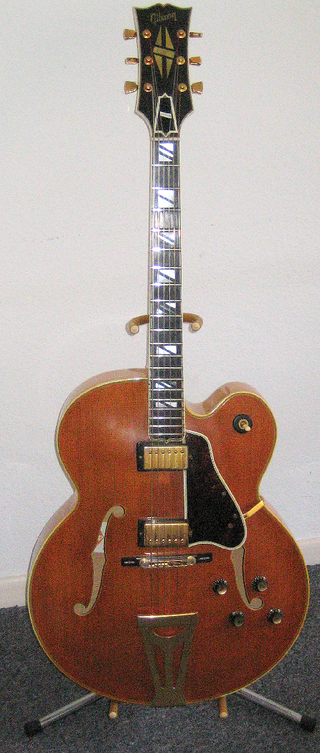
An archtop guitar is a hollow acoustic or semi-acoustic guitar with a full body and a distinctive arched top, whose sound is particularly popular with jazz, blues, and rockabilly players.

The P-90 is a single coil electric guitar pickup produced by Gibson Guitar Corporation since 1946, as well as other vendors. Compared to other single coil designs, such as the ubiquitous Fender single coil, the bobbin for a P-90 is wider but shorter. The Fender style single coil is wound in a taller bobbin, but the wires are closer to the individual poles. This makes the P-90 produce a different type of tone, somewhat warmer with less edge and brightness. As with other single-coil pickups, the P-90 is subject to mains hum unless some form of hum cancellation is used.

The Gibson ES-125 is an archtop, hollow body electric guitar model that was produced by the Gibson Guitar Corporation.

The Gibson J-160E is one of the first acoustic-electric guitars produced by the Gibson Guitar Corporation.

The Gibson ES-175 (1949–2019) is a hollow body Jazz electric guitar manufactured by the Gibson Guitar Corporation. The ES-175 became one of Gibson's most popular guitar designs.

The Gibson Les Paul Doublecut is a double-cutaway version of the Gibson Les Paul electric guitar.
A solid-body musical instrument is a string instrument such as a guitar, bass or violin built without its normal sound box and relying on an electromagnetic pickup system to directly detect the vibrations of the strings; these instruments are usually plugged into an instrument amplifier and loudspeaker to be heard. Solid-body instruments are preferred in situations where acoustic feedback may otherwise be a problem and are inherently both less expensive to build and more rugged than acoustic electric instruments.
The Gibson Les Paul Junior is a solid-body electric guitar introduced in 1954 as an affordable, entry-level Les Paul. It was first released with a single-cutaway body style; models with a double-cutaway body style were later introduced in 1958. The Junior continued through the first three years of the Les Paul/SG body redesign. The initial run was discontinued in 1963.
The Gibson Melody Maker is an electric guitar made by Gibson Guitar Corporation. It has had many body shape variations since its conception in 1959.
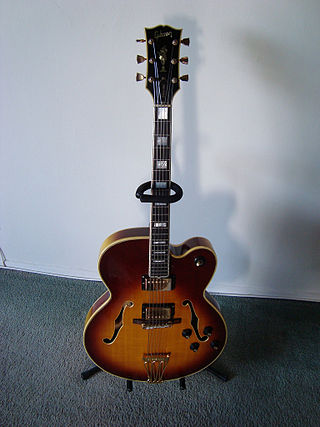
The Byrdland is an electric guitar made by Gibson. Its name derives from the names of guitarists Billy Byrd and Hank Garland for whom Gibson originally custom-built the guitar.
Electric guitar design is a type of industrial design where the looks and efficiency of the shape as well as the acoustical aspects of the guitar are important factors. In the past many guitars have been designed with various odd shapes as well as very practical and convenient solutions to improve the usability of the object.
The Gibson ES series of semi-acoustic guitars are manufactured by the Gibson Guitar Corporation.
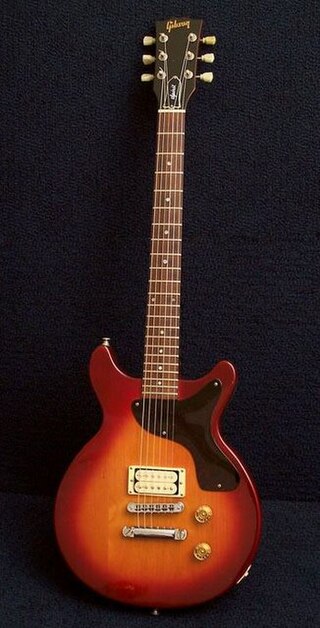
The Gibson Spirit was a guitar model sold under Gibson and Epiphone USA nameplates in the 1980s. This article does not refer to the made-in-China Spirit guitar sold under the Gibson Baldwin Music Education nameplate.

The Gibson ES-350T is an electric guitar model from Gibson Guitar Corporation, released in 1955. The ES-350T is a further development of the Gibson ES-350 model from 1948 and as such has a completely hollow body. The unique feature of the Gibson ES-350T at the time of its market introduction was the reduced width of the rims. As a result, the guitar has a thinner body compared to instruments with a resonance body that is of full thickness. The ES-350T, together with its sister models Gibson ES-225 TDN and Gibson Byrdland, was one of the first models of the thinline guitar type.